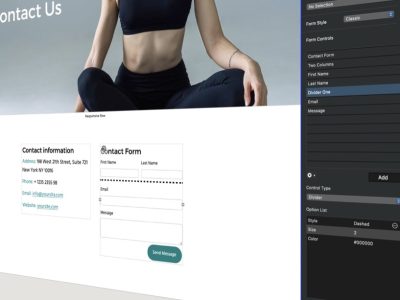In our previous post, we discussed how to take the idea of having your own blog and make it in to a concrete plan of action. once you have your blogging action plan ready, it’s then time to make your blog in EverWeb!
Now that you have your plan, it’s time to create your blog in EverWeb. Here’s our guide on how to successfully create your blog together with some useful hints and tips on how to make blogging super easy for yourself!
Creating Your Blog in EverWeb
As with all things EverWeb, creating a blog is super easy. Just click on the Add Page button then select one of the following:
- The blog page from one of EverWeb’s predefined theme if you have used one for your site or
- The blog page of the blank theme template or
- The blog page of the blank responsive theme template
That’s it! You’ve created your blog!
Good Things to Know About Your Blog
The first thing you’ll notice is that the blog is in fact a directory page containing two pages.It does not matter which theme template you used, the structure is always the same. The three pages in the blog are:
- Blog. This is also known as the blog main or blog index page. The page is used as your index page, so it is the one where your visitors will usually land on first when accessing your blog. The page contains a special widget that lists your blog posts with the latest post being first on the list followed by the second most recent post and so on. You can change how many posts you see in the widget by select the widget then using the widget settings. You can also set other options here such as pagination.
- Posts. The posts page is where you create and manage your blog posts. The posts page is unique in EverWeb as it allows you to create as many posts as you want. The page offers a complete blog post environment to meet almost every possible requirement you may have.
- Archive. This page is very similar to the blog main page in that it includes a special widget that lists all of your blog posts from the most recent descending in order to the first blog post. Use this page as a library of blog posts that your visitors may want to access when they are looking for an older post that’s not listed in the ‘current’ blog main post list.
Unique Blog Features
Of all of the types of page that you can create in EverWeb, the blog has the most unique features…
- You cannot delete the widget in the blog main or blog archive page.
- You cannot delete the posts page or archive page. If you delete the blog main page, you will delete the complete blog i.e. the blog main, posts and archive pages.
- You cannot copy or duplicate the blog
- You can add Text and images to your blog post, but you cannot add include widgets in individual posts
- The posts page let’s you create pages within it i.e. the individual posts
EverWeb’s Blog Tricks and Tips
There are a lot of nifty shortcuts and good to know things in EverWeb’s blogging environment. Below are some useful time and effort saving tips!
- You can duplicate a post by secondary (right) clicking on the post you want to duplicate then select ‘Duplicate’ from the submenu.
- The easiest and most flexible way to hyperlink an object in the blog post editor window is to select it (e.g. a piece of text) then use the Hyperlinks Inspector rather than using the blog blink button in the blog editor window’s Toolbar.
- Click on the draft checkbox when you have a post that you are working on that you don’t want published. This is great so that you can create a list of draft posts for future blog posts.
- Click on the blog post date/time if you want to change the posts date and time. Here you can also check the ‘Use Website Publish Date’ if you want to date/time stamp the post with the date and time that you published the website.
- Use the Fonts Panel to quickly change the font, font size or color rather than using the buttons in the Blog Post Editor Toolbar. Just select your text and press Command+T to call up the Fonts Panel.
- You can create multiple blogs in your project file if you want.
- You can attach a Master page to the posts page, or you can use the Blog Posts Preview window to add objects that you want to see on all of your blog post pages.
- For SEO click on the post you want to add keywords and or a Short Summary to, then click on the Settings Cog and select Edit… This will open the dialog box where you can add your Short Summary description of the post and its related keywords.
- You can also use the Settings Cog in the posts page to import blogs from Apple’s iWeb or WordPress.
Creating your blog in EverWeb is easy to do and there are lots of features to help make your blogging an enjoyable experience for both you and your website visitors!
If you have any questions about blogging with EverWeb, please let us know in the Comments Section below.










Comments